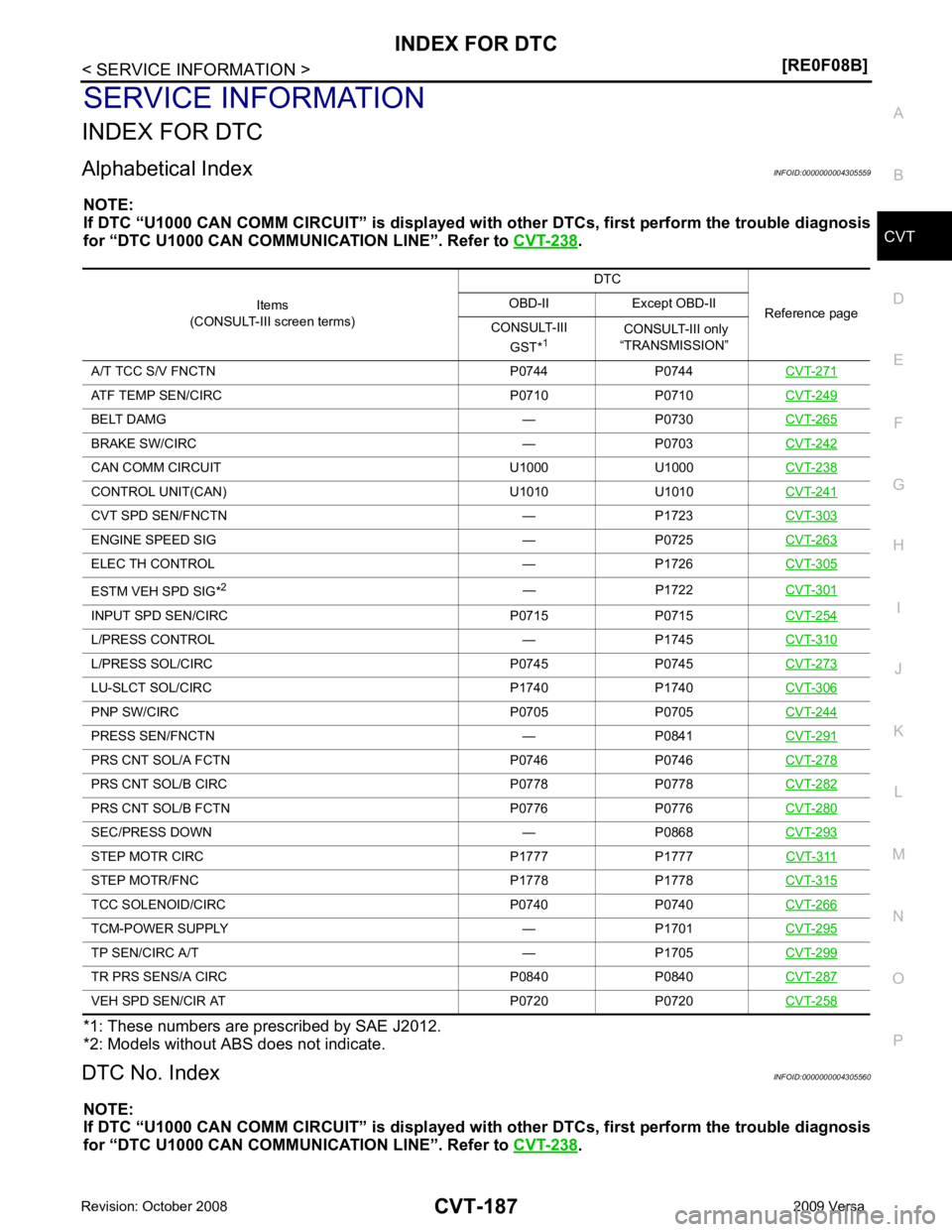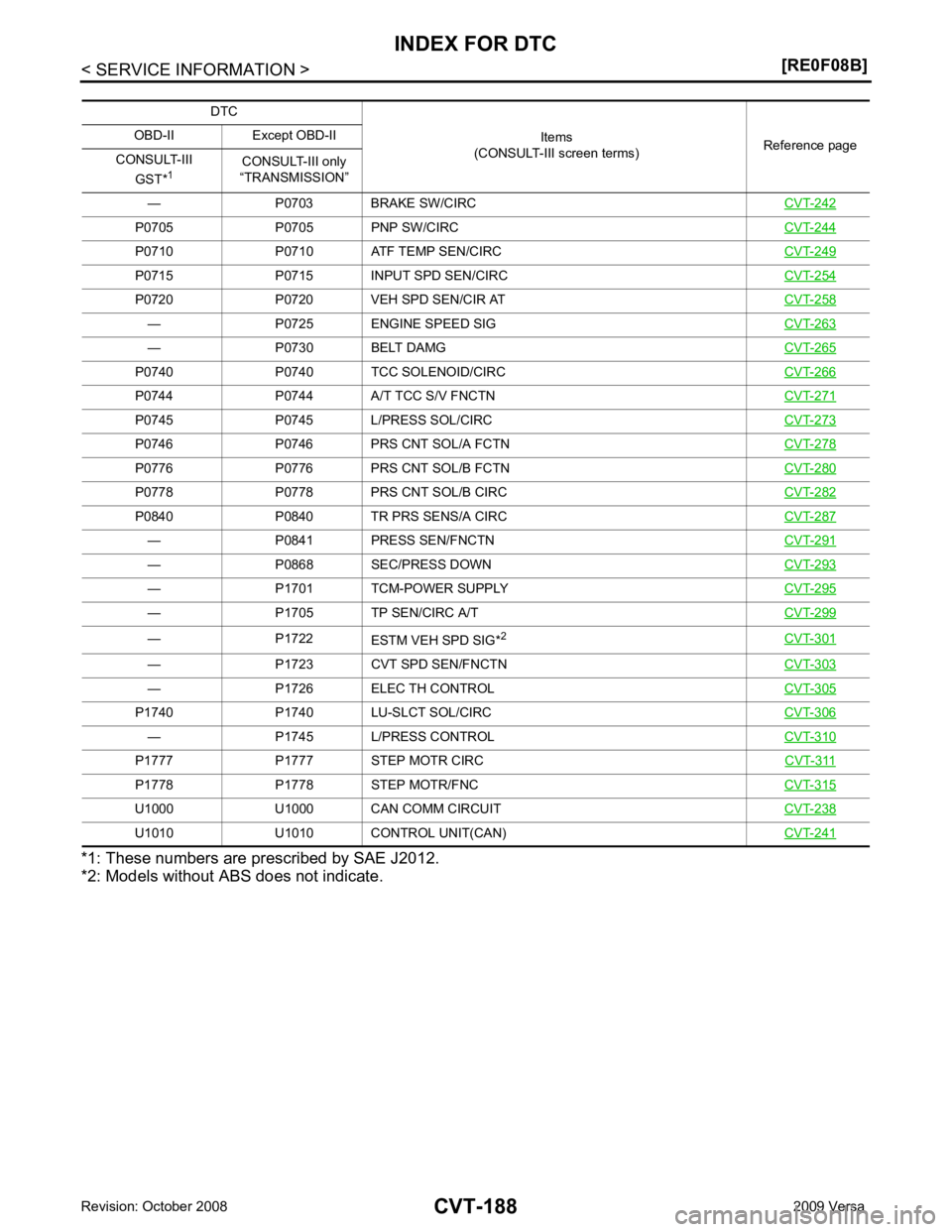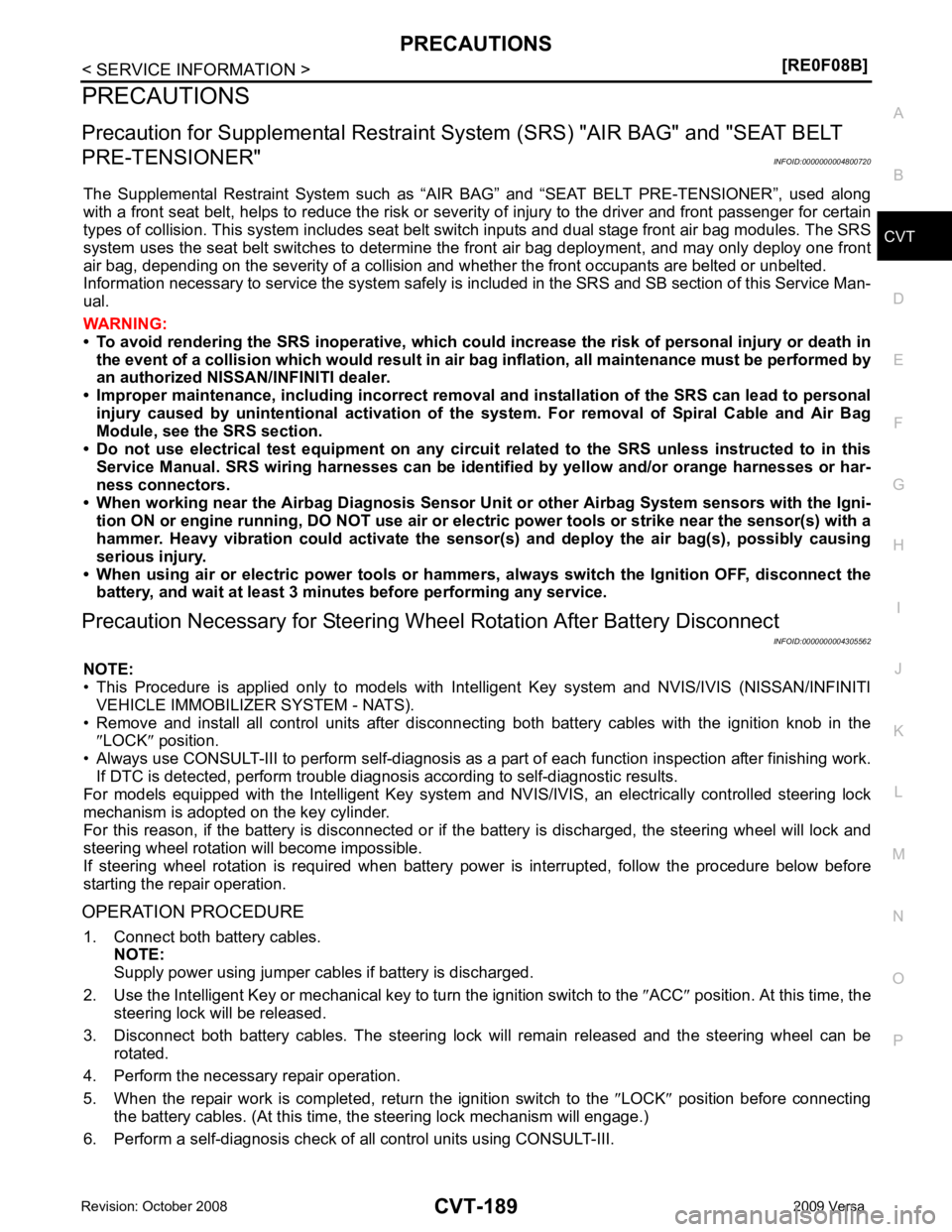2009 NISSAN TIIDA e control
[x] Cancel search: e controlPage 1122 of 4331
![NISSAN TIIDA 2009 Service Repair Manual CVT-178< SERVICE INFORMATION >
[RE0F08A]
KEY INTERLOCK CABLE
4. Slide the slider (A) toward the casing cap (B) while pressing tabs (C) on the slider to separate the slider (A) from the adjust holder
( NISSAN TIIDA 2009 Service Repair Manual CVT-178< SERVICE INFORMATION >
[RE0F08A]
KEY INTERLOCK CABLE
4. Slide the slider (A) toward the casing cap (B) while pressing tabs (C) on the slider to separate the slider (A) from the adjust holder
(](/manual-img/5/57398/w960_57398-1121.png)
CVT-178< SERVICE INFORMATION >
[RE0F08A]
KEY INTERLOCK CABLE
4. Slide the slider (A) toward the casing cap (B) while pressing tabs (C) on the slider to separate the slider (A) from the adjust holder
(D).
5. Remove the casing cap (B) from the cable bracket on the control
device assembly.
6. Remove the key interlock cable from the key interlock rod (E).
7. Remove steering column cover (upper and lower) and instru- ment lower finisher. Refer to IP-11 .
8. Pull out the lock plate (A) from the holder (B).
9. Remove the key interlock cable (1) from the key cylinder (2).
10. Remove the clip (A), and then remove the key interlock cable (1).
INSTALLATION
CAUTION:
• Install key interlock cable in such a way that it will not be damaged by sharp bends, twists or interfer-
ence with adjacent parts.
• After installing key interlock cable to contro l device assembly, make sure that casing cap and
bracket are firmly secured in their positions.
1. Place the selector lever in the “P” position.
2. Turn ignition switch to “ACC” or “ON” position.
3. Set the key interlock cable (1) to the key cylinder (2).
4. Install the lock plate (A) to the holder (B).
5. Turn ignition switch to “LOCK” position. SCIA6975E
SCIA6976E
SCIA6973E
SCIA6976E
Page 1123 of 4331
![NISSAN TIIDA 2009 Service Repair Manual KEY INTERLOCK CABLE
CVT-179
< SERVICE INFORMATION >
[RE0F08A] D
E
F
G H
I
J
K L
M A
B CVT
N
O P
6. Temporarily install the adjust holder (A) to the key interlock rod
(B).
7. Install the casi NISSAN TIIDA 2009 Service Repair Manual KEY INTERLOCK CABLE
CVT-179
< SERVICE INFORMATION >
[RE0F08A] D
E
F
G H
I
J
K L
M A
B CVT
N
O P
6. Temporarily install the adjust holder (A) to the key interlock rod
(B).
7. Install the casi](/manual-img/5/57398/w960_57398-1122.png)
KEY INTERLOCK CABLE
CVT-179
< SERVICE INFORMATION >
[RE0F08A] D
E
F
G H
I
J
K L
M A
B CVT
N
O P
6. Temporarily install the adjust holder (A) to the key interlock rod
(B).
7. Install the casing cap (C) to the cable bracket (D) on the control device assembly.
CAUTION:
• Do not bend or twist key interlock cable excessively when
installing.
• After installing key interlo ck cable to cable bracket (D) on
control device assembly, make sure casing caps (C) is
firmly secured in cable bracket (D) on control device
assembly.
• If casing cap (C) is loose [less than 39.2 N (4.0 kg, 8.8 lb)
removing force], replace key interlock cable.
8. Slide the slider (A) toward the key interlock rod (D) while press- ing the pull lock (B) down to securely connect the adjust holder
(C) with the key interlock rod (D).
CAUTION:
• Do not press tabs when holding slider (A).
• Do not apply any side to side force to key interlock rod (D)
when sliding slider (A).
9. Secure the key interlock cable (1) with the clip (A).
10. Install steering column cover (upper and lower) and instrument lower finisher. Refer to IP-11 .
11. Install the center console assembly. Refer to IP-11 .
12. Install the selector lever knob. Refer to CVT-174, " Selector
Lever Knob Removal and Installation " .
13. Check shift lock system. Refer to CVT-165, " Description " . SCIA6188E
SCIA6978E
SCIA6973E
Page 1131 of 4331

CVT
N
O P
SERVICE INFORMATION
INDEX FOR DTC
Alphabetical Index INFOID:0000000004305559
NOTE:
If DTC “U1000 CAN COMM CIRCUIT” is displayed with other DTCs, first perform the trouble diagnosis
for “DTC U1000 CAN COMMUNICATION LINE”. Refer to CVT-238 .
*1: These numbers are prescribed by SAE J2012.
*2: Models without ABS does not indicate.
DTC No. Index INFOID:0000000004305560
NOTE:
If DTC “U1000 CAN COMM CIRCUIT” is displayed with other DTCs, first perform the trouble diagnosis
for “DTC U1000 CAN COMMUNICATION LINE”. Refer to CVT-238 .
Items
(CONSULT-III screen terms) DTC
Reference page
OBD-II Except OBD-II
CONSULT-III GST* 1 CONSULT-III only
“TRANSMISSION”
A/T TCC S/V FNCTN P0744 P0744 CVT-271ATF TEMP SEN/CIRC P0710 P0710
CVT-249BELT DAMG — P0730
CVT-265BRAKE SW/CIRC — P0703
CVT-242CAN COMM CIRCU
IT U1000 U1000 CVT-238CONTROL UNIT(CAN) U1010 U1010
CVT-241CVT SPD SEN/FNCTN — P1723
CVT-303ENGINE SPEED SIG — P0725
CVT-263ELEC TH CONTROL — P1726
CVT-305ESTM VEH SPD SIG*
2
— P1722CVT-301INPUT SPD SEN/CIRC P0715 P0715
CVT-254L/PRESS CONTROL — P1745
CVT-310L/PRESS SOL/CIRC P0745 P0745
CVT-273LU-SLCT SOL/CIRC P1740 P1740
CVT-306PNP SW/CIRC P0705 P0705
CVT-244PRESS SEN/FNCTN — P0841
CVT-291PRS CNT SOL/A FCTN P0746 P0746
CVT-278PRS CNT SOL/B CIRC P0778 P0778
CVT-282PRS CNT SOL/B FCTN P0776 P0776
CVT-280SEC/PRESS DOWN — P0868
CVT-293STEP MOTR CIRC P1777 P1777
CVT-311STEP MOTR/FNC P1778 P1778
CVT-315TCC SOLENOID/CIRC P0740 P0740
CVT-266TCM-POWER SUPPLY — P1701
CVT-295TP SEN/CIRC A/T — P1705
CVT-299TR PRS SENS/A CIRC P0840 P0840
CVT-287VEH SPD SEN/CIR AT P0720 P0720
CVT-258
Page 1132 of 4331

P0705 P0705 PNP SW/CIRC
CVT-244P0710 P0710 ATF TEMP SEN/CIRC
CVT-249P0715 P0715 INPUT SPD SEN/CIRC
CVT-254P0720 P0720 VEH SPD SEN/CIR AT
CVT-258— P0725 ENGINE SPEED SIG
CVT-263— P0730 BELT DAMG
CVT-265P0740 P0740 TCC SOLENOID/CIRC
CVT-266P0744 P0744 A/T TCC S/V FNCTN
CVT-271P0745 P0745 L/PRESS SOL/CIRC
CVT-273P0746 P0746 PRS CNT SOL/A FCTN
CVT-278P0776 P0776 PRS CNT SOL/B FCTN
CVT-280P0778 P0778 PRS CNT SOL/B CIRC
CVT-282P0840 P0840 TR PRS SENS/A CIRC
CVT-287— P0841 PRESS SEN/FNCTN
CVT-291— P0868 SEC/PRESS DOWN
CVT-293— P1701 TCM-POWER SUPPLY
CVT-295— P1705 TP SEN/CIRC A/T
CVT-299— P1722
ESTM VEH SPD SIG*2
CVT-301— P1723 CVT SPD SEN/FNCTN
CVT-303— P1726 ELEC TH CONTROL
CVT-305P1740 P1740 LU-SLCT SOL/CIRC
CVT-306— P1745 L/PRESS CONTROL
CVT-310P1777 P1777 STEP MOTR CIRC
CVT-311P1778 P1778 STEP MOTR/FNC
CVT-315U1000 U1000 CAN COMM CIRCUIT
CVT-238U1010 U1010 CONTROL UNIT(CAN)
CVT-241
Page 1133 of 4331

CVT
N
O P
PRECAUTIONS
Precaution for Supplemental Restraint System (SRS) "AIR BAG" and "SEAT BELT
PRE-TENSIONER" INFOID:0000000004800720
The Supplemental Restraint System such as “A IR BAG” and “SEAT BELT PRE-TENSIONER”, used along
with a front seat belt, helps to reduce the risk or severi ty of injury to the driver and front passenger for certain
types of collision. This system includes seat belt switch inputs and dual stage front air bag modules. The SRS
system uses the seat belt switches to determine the front air bag deployment, and may only deploy one front
air bag, depending on the severity of a collision and w hether the front occupants are belted or unbelted.
Information necessary to service the system safely is included in the SRS and SB section of this Service Man-
ual.
WARNING:
• To avoid rendering the SRS inoper ative, which could increase the risk of personal injury or death in
the event of a collision which would result in air bag inflation, all maintenance must be performed by
an authorized NISSAN/INFINITI dealer.
• Improper maintenance, including in correct removal and installation of the SRS can lead to personal
injury caused by unintentional act ivation of the system. For removal of Spiral Cable and Air Bag
Module, see the SRS section.
• Do not use electrical test equipm ent on any circuit related to the SRS unless instructed to in this
Service Manual. SRS wiring harnesses can be identi fied by yellow and/or orange harnesses or har-
ness connectors.
• When working near the Airbag Diagnosis Sensor Un it or other Airbag System sensors with the Igni-
tion ON or engine running, DO NOT use air or el ectric power tools or strike near the sensor(s) with a
hammer. Heavy vibration could activate the sensor( s) and deploy the air bag(s), possibly causing
serious injury.
• When using air or electric power tools or hammers , always switch the Ignition OFF, disconnect the
battery, and wait at least 3 minutes before performing any service.
Precaution Necessary for Steering Wh eel Rotation After Battery Disconnect
INFOID:0000000004305562
NOTE:
• This Procedure is applied only to models with Intell igent Key system and NVIS/IVIS (NISSAN/INFINITI
VEHICLE IMMOBILIZER SYSTEM - NATS).
• Remove and install all control units after disconnecti ng both battery cables with the ignition knob in the
″ LOCK ″ position.
• Always use CONSULT-III to perform self-diagnosis as a part of each function inspection after finishing work.
If DTC is detected, perform trouble diagnosis according to self-diagnostic results.
For models equipped with the Intelligent Key system and NVIS/IVIS, an electrically controlled steering lock
mechanism is adopted on the key cylinder.
For this reason, if the battery is disconnected or if the battery is discharged, the steering wheel will lock and
steering wheel rotation will become impossible.
If steering wheel rotation is required when battery pow er is interrupted, follow the procedure below before
starting the repair operation.
OPERATION PROCEDURE 1. Connect both battery cables. NOTE:
Supply power using jumper cables if battery is discharged.
2. Use the Intelligent Key or mechanical key to turn the ignition switch to the ″ACC ″ position. At this time, the
steering lock will be released.
3. Disconnect both battery cables. The steering lock will remain released and the steering wheel can be
rotated.
4. Perform the necessary repair operation.
5. When the repair work is completed, return the ignition switch to the ″LOCK ″ position before connecting
the battery cables. (At this time, the steering lock mechanism will engage.)
6. Perform a self-diagnosis check of al l control units using CONSULT-III.
Page 1147 of 4331
![NISSAN TIIDA 2009 Service Repair Manual CVT SYSTEM
CVT-203
< SERVICE INFORMATION >
[RE0F08B] D
E
F
G H
I
J
K L
M A
B CVT
N
O P
Hydraulic Control System
INFOID:0000000004305575
TCM Function INFOID:0000000004305576
The function of the TCM is NISSAN TIIDA 2009 Service Repair Manual CVT SYSTEM
CVT-203
< SERVICE INFORMATION >
[RE0F08B] D
E
F
G H
I
J
K L
M A
B CVT
N
O P
Hydraulic Control System
INFOID:0000000004305575
TCM Function INFOID:0000000004305576
The function of the TCM is](/manual-img/5/57398/w960_57398-1146.png)
CVT SYSTEM
CVT-203
< SERVICE INFORMATION >
[RE0F08B] D
E
F
G H
I
J
K L
M A
B CVT
N
O P
Hydraulic Control System
INFOID:0000000004305575
TCM Function INFOID:0000000004305576
The function of the TCM is to:
• Receive input signals sent from various switches and sensors.
• Determine required line pressure, shifting point, and lock-up operation.
• Send required output signals to the step motor and the respective solenoids.
CONTROL SYSTEM OUTLINE The CVT senses vehicle operating conditions through vari ous sensors. It always controls the optimum shift
position and reduces shifting and lock-up shocks. SCIA1807E
SENSORS (or SIGNAL)
⇒TCM
⇒ACTUATORS
PNP switch
Accelerator pedal position signal
Closed throttle position signal
Engine speed signal
CVT fluid temperature sensor
Vehicle speed signal
Overdrive control signal
Stop lamp switch signal
Primary speed sensor
Secondary speed sensor
Secondary pressure sensor Shift control
Line pressure control
Primary pressure control
Secondary pressure control
Lock-up control
Engine brake control
Vehicle speed control
Fail-safe control
Self-diagnosis
CONSULT-III co mmunication
line
Duet-EA control
CAN system
On board diagnosis Step motor
Torque converter clutch solenoid
valve
Lock-up select solenoid valve
Line pressure solenoid valve
Secondary pressure solenoid
valve
Shift position indicator
O/D OFF indicator lamp
Starter relay
Page 1149 of 4331
![NISSAN TIIDA 2009 Service Repair Manual CVT SYSTEM
CVT-205
< SERVICE INFORMATION >
[RE0F08B] D
E
F
G H
I
J
K L
M A
B CVT
N
O P
*1: Input by CAN communications.
*2: Output by CAN communications.
*3: If these input and output signals are diff NISSAN TIIDA 2009 Service Repair Manual CVT SYSTEM
CVT-205
< SERVICE INFORMATION >
[RE0F08B] D
E
F
G H
I
J
K L
M A
B CVT
N
O P
*1: Input by CAN communications.
*2: Output by CAN communications.
*3: If these input and output signals are diff](/manual-img/5/57398/w960_57398-1148.png)
CVT SYSTEM
CVT-205
< SERVICE INFORMATION >
[RE0F08B] D
E
F
G H
I
J
K L
M A
B CVT
N
O P
*1: Input by CAN communications.
*2: Output by CAN communications.
*3: If these input and output signals are different, the TCM triggers the fail-safe function.
Line Pressure and Secondary Pressure Control INFOID:0000000004305579
• When an input torque signal equivalent to the engine drive force is sent from the ECM to the TCM, the TCM
controls the line pressure solenoid valve and secondary pressure solenoid valve.
• This line pressure solenoid controls the pressure regulat or valve as the signal pressure and adjusts the pres-
sure of the operating oil discharged from the oil pump to the line pressure most appropriate to the driving
state. Secondary pressure is cont rolled by decreasing line pressure.
NORMAL CONTROL Optimize the line pressure and secondary pressure, dependi ng on driving conditions, on the basis of the throt-
tle position, the engine speed, the primary pulley (input ) revolution speed, the secondary pulley (output) revo-
lution speed, the brake signal, the PNP switch signal, the lock-up signal, the voltage, the target gear ratio, the
fluid temperature, and the fluid pressure.
FEEDBACK CONTROL When controlling the normal fluid pressure or the sele cted fluid pressure, the secondary pressure can be set
more accurately by using the fluid pressure sensor to detect the secondary pressure and controlling the feed-
back.
Shift Control INFOID:0000000004305580
In order to select the gear ratio which can obtain the dr iving force in accordance with driver's intention and the
vehicle condition, TCM monitors the driving conditions, such as the vehicle speed and the throttle position and
selects the optimum gear ratio, and determines the gear change steps to the gear ratio. Then send the com-
Out-
put Step motor X X
TCC solenoid valve X X X
Lock-up select solenoid valve X X X
Line pressure solenoid valve X X X X
Secondary pressure solenoid valve X X X
O/D OFF indicator signal (*2)
X X
Control item
Fluid
pressure
control Select con-
trol Shift control
Lock-up
control CAN com-
munication
control Fail-safe
function
(*3) SCIA1846E
Page 1150 of 4331
![NISSAN TIIDA 2009 Service Repair Manual CVT-206< SERVICE INFORMATION >
[RE0F08B]
CVT SYSTEM
mand to the step motor, and control the flow-in/flow-out of line pressure from the primary pulley to determine
the position of the moving-pulley an NISSAN TIIDA 2009 Service Repair Manual CVT-206< SERVICE INFORMATION >
[RE0F08B]
CVT SYSTEM
mand to the step motor, and control the flow-in/flow-out of line pressure from the primary pulley to determine
the position of the moving-pulley an](/manual-img/5/57398/w960_57398-1149.png)
CVT-206< SERVICE INFORMATION >
[RE0F08B]
CVT SYSTEM
mand to the step motor, and control the flow-in/flow-out of line pressure from the primary pulley to determine
the position of the moving-pulley and control the gear ratio.
NOTE:
The gear ratio is set for every position separately.
“D” POSITION
Shifting over all the ranges of gear ratios from the lowest to the high-
est.
OVERDRIVE-OFF MODE
Use this position for the improved engine braking.
“L” POSITION
By limiting the gear range to the lowest position, the strong driving
force and the engine brake can be secured.
DOWNHILL ENGINE BRAKE CONTROL (AUTO ENGINE BRAKE CONTROL)
When downhill is detected with the accelerator pedal released, the engine brake will be strengthened up by
downshifting so as not to accelerate the vehicle more than necessary.
ACCELERATION CONTROL
According to vehicle speed and a change of accelerator pedal angle, driver's request for acceleration and driv-
ing scene are judged. This function assists improvem ent in acceleration feeling by making the engine speed
proportionate to the vehicle speed. And a shift map which can gain a larger driving force is available for com-
patibility of mileage with driveability. SCIA7958E
SCIA1953E
SCIA1955E